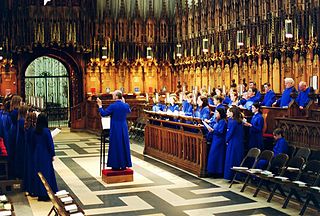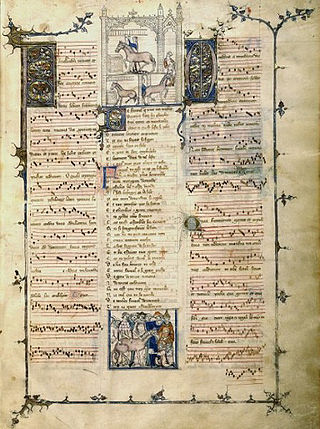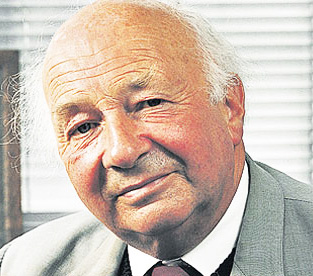John Potter | |
|---|---|
 Potter performing with Trio Mediæval | |
| Occupations |
|
| Years active | 1970s - present |
| Website | john-potter |
John Potter is an English tenor and academic.
John Potter | |
|---|---|
 Potter performing with Trio Mediæval | |
| Occupations |
|
| Years active | 1970s - present |
| Website | john-potter |
John Potter is an English tenor and academic.
John Potter's musical education began as a chorister in the Choir of King's College, Cambridge, [1] after which he became a scholar at The King's School, Canterbury and exhibitioner at Gonville and Caius College, Cambridge. His coaches included lieder specialist Walter Gruner, accompanist Paul Hamburger, and the tenor Peter Pears.
Potter specialises in early and contemporary classical music vocal music. In addition to his solo work, he has performed with many vocal ensembles including the Hilliard Ensemble, The Swingle Singers, The Dowland Project, the Gavin Bryars Ensemble, and Red Byrd, of which he is a co-founder. His discography includes over 100 recordings encompassing his eclectic musical interests including Léonin and Led Zeppelin. [2] He has received a fifth gold disc for the Hilliard Ensemble's Officium album.
He is also an ensemble coach, mentoring groups such as Trio Mediæval from Norway, The Kassiopeia Ensemble from the Netherlands, and Juice from the United Kingdom. His later collaborations have included Being Dufay with electronic music composer Ambrose Field [3] and the lutenist and vihuela player Ariel Abramovich.
Potter is a reader emeritus for the Music Department at the University of York; before retirement he was the director of the Vocal Studies postgraduate program. His research interests include the sociology of vocal music and vocal repertory, especially Renaissance and contemporary music. [4]
Potter is the editor of the Cambridge Companion to Singing (1998) and is the author of numerous articles in academic publications. His books include:

Claudio Giovanni Antonio Monteverdi was an Italian composer, choirmaster and string player. A composer of both secular and sacred music, and a pioneer in the development of opera, he is considered a crucial transitional figure between the Renaissance and Baroque periods of music history.

A choir is a musical ensemble of singers. Choral music, in turn, is the music written specifically for such an ensemble to perform or in other words is the music performed by the ensemble. Choirs may perform music from the classical music repertoire, which spans from the medieval era to the present, or popular music repertoire. Most choirs are led by a conductor, who leads the performances with arm, hand, and facial gestures.

A jazz band is a musical ensemble that plays jazz music. Jazz bands vary in the quantity of its members and the style of jazz that they play but it is common to find a jazz band made up of a rhythm section and a horn section.
Vibrato is a musical effect consisting of a regular, pulsating change of pitch. It is used to add expression to vocal and instrumental music. Vibrato is typically characterized in terms of two factors: the amount of pitch variation and the speed with which the pitch is varied.
A countertenor (also contra tenor) is a type of classical male singing voice whose vocal range is equivalent to that of the female contralto or mezzo-soprano voice types, generally extending from around G3 to D5 or E5, although a sopranist (a specific kind of countertenor) may match the soprano's range of around C4 to C6. Countertenors often have tenor or baritone chest voices, but sing in falsetto or head voice much more often than they do in their chest voice.
A tenor is a type of classical male singing voice whose vocal range lies between the countertenor and baritone voice types. It is the highest male chest voice type. Composers typically write music for this voice in the range from the second B below middle C to the G above middle C (i.e. B2 to G4) in choral music, and from the second B flat below middle C to the C above middle C (B♭2 to C5) in operatic music, but the range can extend at either end. Subtypes of tenor include the leggero tenor, lyric tenor, spinto tenor, dramatic tenor, heldentenor, and tenor buffo or spieltenor.

Sir Peter Neville Luard Pears was an English tenor. His career was closely associated with the composer Benjamin Britten, his personal and professional partner for nearly forty years.

Singing is the act of creating musical sounds with the voice. A person whose profession is singing is called a singer, artist or vocalist. Singers perform music that can be sung with or without accompaniment by musical instruments. Singing is often done in an ensemble of musicians, such as a choir. Singers may perform as soloists or accompanied by anything from a single instrument up to a symphony orchestra or big band. Different singing styles include art music such as opera and Chinese opera, Indian music, Greek music, Japanese music, and religious music styles such as gospel, traditional music styles, world music, jazz, blues, ghazal, and popular music styles such as pop, rock, and electronic dance music.

Vespro della Beata Vergine, SV 206, is a musical setting by Claudio Monteverdi of the evening vespers on Marian feasts, scored for soloists, choirs, and orchestra. It is an ambitious work in scope and in its variety of style and scoring, and has a duration of around 90 minutes. Published in Venice as Sanctissimae Virgini Missa senis vocibus ac Vesperae pluribus decantandae, cum nonnullis sacris concentibus, ad Sacella sive Principum Cubicula accommodata, it is sometimes called Monteverdi's Vespers of 1610.
Pérotin was a composer associated with the Notre Dame school of polyphony in Paris and the broader ars antiqua musical style of high medieval music. He is credited with developing the polyphonic practices of his predecessor Léonin, with the introduction of three and four-part harmonies.

Ars nova refers to a musical style which flourished in the Kingdom of France and its surroundings during the Late Middle Ages. More particularly, it refers to the period between the preparation of the Roman de Fauvel (1310s) and the death of composer Guillaume de Machaut in 1377. The term is sometimes used more generally to refer to all European polyphonic music of the fourteenth century. For instance, the term "Italian ars nova" is sometimes used to denote the music of Francesco Landini and his compatriots, although Trecento music is the more common term for the contemporary 14th-century music in Italy. The "ars" in "ars nova" can be read as "technique", or "style". The term was first used in two musical treatises, titled Ars novae musicae by Johannes de Muris, and a collection of writings attributed to Philippe de Vitry often simply called "Ars nova" today. Musicologist Johannes Wolf first applied to the term as description of an entire era in 1904.
In music, portamento is a pitch sliding from one note to another. The term originated from the Italian expression "portamento della voce", denoting from the beginning of the 17th century its use in vocal performances and emulation by members of the violin family and certain wind instruments, and is sometimes used interchangeably with anticipation. It is also applied to one type of glissando on, e.g., slide trombones, as well as to the "glide" function of steel guitars and synthesizers; in the latter it is often used to add a melancholic effect to the overall melody.
Hilliard Ensemble was a British male vocal quartet originally devoted to the performance of early music. The group was named after the Elizabethan miniaturist painter Nicholas Hilliard. Founded in 1974, the group disbanded in 2014.
Bel canto —with several similar constructions —is a term with several meanings that relate to Italian singing.
Amos Leon Thomas Jr., known professionally as Leon Thomas, was an American jazz and blues vocalist, born in East St. Louis, Illinois, and known for his bellowing glottal-stop style of free jazz singing in the late 1960s and 1970s.

The concerto delle donne was an ensemble of professional female singers of late Renaissance music in Italy. The term usually refers to the first and most influential group in Ferrara, which existed between 1580 and 1597. Renowned for their technical and artistic virtuosity, the Ferrarese group's core members were the sopranos Laura Peverara, Livia d'Arco and Anna Guarini.
Baritenor is a portmanteau (blend) of the words "baritone" and "tenor". It is used to describe both baritone and tenor voices. In Webster's Third New International Dictionary it is defined as "a baritone singing voice with virtually a tenor range". However, the term was defined in several late 19th century and early 20th century music dictionaries, such as The American History and Encyclopedia of Music, as "a low tenor voice, almost baritone [sic]."

John Barry Steane was an English music critic, musicologist, literary scholar and teacher, with a particular interest in singing and the human voice. His 36-year career as a schoolmaster overlapped with his career as a music critic and author of books on Elizabethan drama, and opera and concert singers.
Rogers Henry Lewis Covey-Crump is an English tenor noted for his performances in both early music and contemporary classical music. He has sometimes been identified as an haute-contre tenor. He has performed for over 50 years in choirs and ensembles such as the Hilliard Ensemble, and as a soloist. He has been especially in demand for the part of the Evangelist in Bach's St Matthew Passion and St John Passion. He also specialises in vocal tuning, and has written articles on the subject.

Osbert Parsley was an English Renaissance composer and chorister. Few details of his life are known, but he evidently married in 1558, and lived for a period in the parish of St Saviour's Church, Norwich. A boy chorister at Norwich Cathedral, Parsley worked there throughout his musical career. He was first mentioned as a lay clerk, was appointed a "singing man" in c. 1534, and was probably the cathedral's unofficial organist for half a century. His career spanned the reigns of Henry VIII and all three of his children. After the Reformation of 1534, the lives of English church musicians changed according to the official policy of each monarch.
{{cite web}}: CS1 maint: archived copy as title (link)